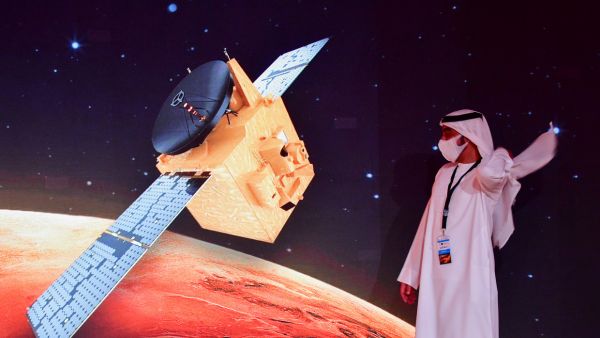A United Arab Emirates spacecraft, the Mars orbiter Hope, successfully entered orbit around the Red Planet about 11 a.m. EST Tuesday.
The probe is the first since NASA's Insight lander in November 2018 to reach the planet. The successful arrival at Mars makes the UAE the fifth nation to reach Mars, following the United States, Russia, China and India.
Welcome to Mars! UAE's Hope probe enters orbit around Red Planet. https://t.co/KftpXt0P6B pic.twitter.com/qR7spFzPHP
— SPACE.com (@SPACEdotcom) February 9, 2021
After all of these years, it's been achieved, today, by the UAE, and it is just an incredible moment. It's such an honor to have such a moment," Fahad Al Mheiri, an executive director with the UAE Space Agency, said during a live broadcast.
Hope (or Al Amal in Arabic) will study the Martian atmosphere for at least two years.
RELATED New era of Mars exploration begins as craft nears Red Planet
A new visitor to Mars arrives as the UAE’s Hope Probe, the first interplanetary mission in the Arab world, enters the Red Planet’s orbit, culminating a seven-month, 300-million-mile journey from Earth.
— Friday Magazine (@Friday_Magazine) February 9, 2021
Watch this historic event live: https://t.co/Ob1HI0iQ2W#ArabstoMars pic.twitter.com/P4sDq79qUF
On Tuesday, the probe fired thrusters for 27 minutes to slow down and achieve its intended orbit -- burning about half of its fuel supply. Teams of scientists and space enthusiasts listened as the UAE space agency confirmed the spacecraft was healthy and in the right place.
After the successful orbital insertion, minor corrections still may be made, said Pete Withnell, a program manager for the Hope mission at the University of Colorado Boulder.
The UAE mission also starts an unprecedented year of Mars exploration, as China's Tianwen-1 orbiter and rover is due to arrive at Mars on Wednesday, followed by NASA's Perseverance rover Feb. 18.
Let's hope that UAE's #HopeProbe Mars probe enters the orbit around the Red Planet successfully today at around 3 p.m. UT. A live coverage of the event can be watched here: https://t.co/gaTMXWZa2G pic.twitter.com/fYXD7fcs1M
— Austr. Space Forum (@oewf) February 9, 2021
RELATED NASA's most advanced rover heads to Mars
All three spacecraft have advanced robotics technology because there's an 11-minute delay in communication signals between Earth and Mars.
Hope, Tianwen-1 and Perseverance were launched in July on a seven-month journey as Mars and Earth were nearing their closest approach in orbit around the Sun.
Now that Hope has reached orbit, scientists in the Emirates and elsewhere are eager to receive data about the atmosphere from the spacecraft's imaging equipment, said Sarah al Amiri, minister of advanced sciences for the UAE.
Prepare for the worst, but hope for the best. Today, the UAE’s Hope orbiter succeeded in entering Mars orbit. The mission’s objective? The first complete picture of the Martian atmosphere.
— National Air and Space Museum (@airandspace) February 9, 2021
Diagram: UAE Space Agency and BBC pic.twitter.com/Px47XLq2vh
RELATED UAE's historic first Mars mission launches from Japan
"The first reason we chose this mission was to develop the capabilities of a team of technology developers and engineers rapidly and teach them how to take on large risks," Al Amiri said.
A mission to Mars, rather than to the moon or Earth orbit, required extremely complex physics of orbital mechanics, she said.
The UAE is eager to contribute to the global understanding of Mars, and to develop interplanetary sciences as a result of the mission, Al Amiri said.
"So there are several reasons that Mars was the sweet spot, the right destination for all of this to happen," she said.
According to Al Amiri, the UAE government had declared that the Hope mission was a success even before Tuesday, because such a team of experts was able to build the craft, launch it and get it to Mars.
"But of course, for me, I am eager to begin the science part of the mission, which is the overall goal," she said.
Over the next couple of months, instruments on the probe will be tested before routine science begins.
Hope will orbit the entire planet at different locations to gather the most comprehensive picture of Mars weather -- especially during changes of seasons. The spacecraft will build on data gathered by NASA's 2014 orbiter, MAVEN, which analyzed portions of Mars' upper atmosphere.
MAVEN determined that Mars had lost large amounts of its atmosphere over thousands of years, a phenomenon that Hope may explain further, according to NASA and the UAE Space Agency.
Such data may reveal "any indication of what the Mars atmosphere was once like, and what it will be like in the future," astrophysicist and science communicator Neil deGrasse Tyson said in a video posted to Twitter recently by the agency.
This article has been adapted from its original source.








